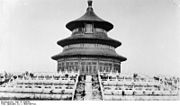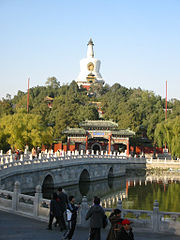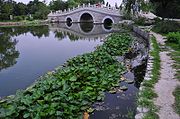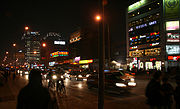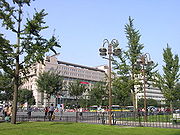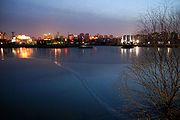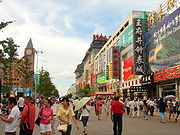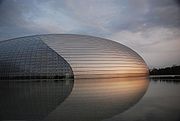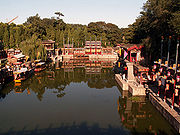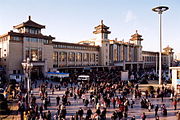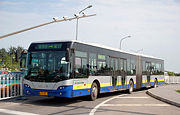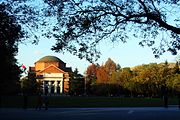
Beijing
About this schools Wikipedia selection
SOS Children has tried to make Wikipedia content more accessible by this schools selection. To compare sponsorship charities this is the best sponsorship link.
|
||||||||||||||||||||||||||||||||||||||||||||||||||||||||||||||||||||||||||||
| Beijing | |||||||||||||||||||||||||||
|---|---|---|---|---|---|---|---|---|---|---|---|---|---|---|---|---|---|---|---|---|---|---|---|---|---|---|---|
| Chinese | 北京 | ||||||||||||||||||||||||||
| Hanyu Pinyin | Běijīng [Listen] |
||||||||||||||||||||||||||
| Postal Map | Peking | ||||||||||||||||||||||||||
|
|||||||||||||||||||||||||||
Beijing (pronounced /beɪˈdʒɪŋ/, Chinese: 北京; pinyin: Běijīng, [peɪ˨˩ t͡ɕiŋ˥]), also known as Peking (pronounced /piːˈkɪŋ/ or /peɪˈkɪŋ/), is a metropolis in Northern China, and the capital of the People's Republic of China. Governed as a municipality under direct administration of the central government, Beijing borders Hebei Province to the north, west, south, and for a small section in the east, and Tianjin Municipality to the southeast. Beijing is one of the Four Great Ancient Capitals of China.
Beijing is divided into 14 urban and suburban districts and two rural counties. Beijing is a major transportation hub, with dozens of railways, roads and motorways passing through the city. It is also the destination of many international flights arriving in China. Beijing is recognized as the political, educational, and cultural centre of the People's Republic of China, while Shanghai and Hong Kong predominate in economic fields. The city hosted the 2008 Olympic Games.
Few cities in the world besides Beijing have served as the political and cultural centre of an area as immense as China for so long. The Encyclopædia Britannica describes it as "one of the world's great cities," and declares that the city has been an integral part of China’s history for centuries; there is scarcely a major building of any age in Beijing that doesn't have at least some national historical significance. Beijing is renowned for its opulent palaces, temples, and huge stone walls and gates. Its art treasures and universities have long made the city a centre of culture and art in China.
Etymology and names
"Beijing" means "Northern Capital", in line with the common East Asian tradition whereby capital cities are explicitly named as such. Other cities that are similarly named include Nanjing, China, meaning "southern capital"; Tokyo, Japan, and Đông Kinh, now Hanoi, Vietnam, both meaning "eastern capital" (東京); as well as Kyoto, Japan, and Gyeongseong ( 京 城; now Seoul, Korea, both meaning simply "capital".
Peking is the name of the city according to Chinese Postal Map Romanization, and the traditional customary name for Beijing in English. The term Peking originated with French missionaries four hundred years ago and corresponds to an older pronunciation predating a subsequent sound change in Mandarin from [kʲ] to [tɕ] ([tɕ] is represented in pinyin as j, as in Beijing). It is still used in many languages.
The pronunciation "Peking" is also closer to the Fujianese dialect of Amoy or Min Nan spoken in the city of Xiamen, a port where European traders first landed in the 16th century, while "Beijing" more closely approximates the Mandarin dialect's pronunciation.
The city has been renamed several times. During the Jin Dynasty, the city was known as Zhongdu ( 中都), and then later under the Mongol Yuan Dynasty as Dadu ( 大 都) in Chinese and Daidu to Mongols (also recorded as Cambuluc by Marco Polo). Twice in the city's history, the name of the city was changed from Beijing (Peking) to Beiping (Peiping) ( 北平; Pinyin: Běipíng; Wade-Giles: Pei-p'ing), literally "Northern Peace". This occurred first under the Hongwu Emperor of the Ming Dynasty, and again in 1928 with the Kuomintang (KMT) government of the Republic of China. On each occasion, the name change removed the element meaning "capital" (京) to reflect the fact the national capital had changed to Nanjing, in Jiangsu Province. Such renaming was reverted twice; this occurred first under the Yongle Emperor of the Ming Dynasty, who moved the capital from Nanjing back to Beijing, and again in 1949, when the Communist Party of China restored Beijing as its capital after the founding of the People's Republic of China. The abbreviation of the municipality is its second character (京) and is used on licence plates, among other things.
Yanjing ( 燕 京; Pinyin: Yānjīng; Wade-Giles: Yen-ching) is and has been another popular informal name for Beijing, a reference to the ancient State of Yan that existed here during the Zhou Dynasty. This name is reflected in the locally brewed Yanjing Beer as well as Yenching University, an institution of higher learning that was merged into Peking University.
- The history section below outlines other historical names of Beijing.
History
Early history
The earliest remnants of human habitation in the Beijing municipality are found in the caves of Dragon Bone Hill near the village of Zhoukoudian in Fangshan District, where the Peking Man lived. Homo erectus fossils from the caves date to 230,000 to 250,000 years ago. Paleolithic homo sapiens also lived there about 27,000 years ago. There were cities in the vicinities of Beijing by the 1st millennium BC, and the capital of the State of Yan, one of the powers of the Warring States Period (473-221 BC), Ji (薊/蓟), was established in present-day Beijing.
After the fall of the Yan, the subsequent Qin, Han, and Jin dynasties set up local prefectures in the area. During the fall of the Han, it was the seat of the warlord Gongsun Zan. In Tang Dynasty it became the headquarters for Fanyang jiedushi, the virtual military governor of current northern Hebei area. The An Shi Rebellion was also launched from here in AD 755.
Medieval period
In 936, the Later Jin Dynasty (936-947) of northern China ceded a large part of its northern frontier, including modern Beijing, to the Khitan Liao Dynasty. In 938, the Liao Dynasty set up a secondary capital in what is now Beijing, and called it Nanjing (the "Southern Capital"). In 1125, the Jurchen Jin Dynasty conquered Liao, and in 1153 moved its capital to Liao's Nanjing, calling it Zhongdu (中都), the "central capital." Zhongdu was situated in what is now the area centered around Tianningsi, slightly to the southwest of central Beijing. Some of the oldest existing relics in Beijing, such as the Tianning Temple, date to the Liao.
Mongol forces burned Zhongdu to the ground in 1215 in what is now known as the Battle of Beijing. Later in 1264, in preparation for the conquest of all of China to establish the Yuan Dynasty, Kublai Khan decided to rebuild it slightly north to the centre of the Jin capital, and in 1272, he made this city his capital as Dadu (大都, Chinese for "great capital"), or Daidu to the Mongols, otherwise spelled as Cambaluc or Cambuluc in Marco Polo's accounts. Construction of Dadu finished in 1293. The decision of Kublai Khan greatly enhanced the status of a city that had been situated on the northern fringe of China proper. The centre of Dadu was situated slightly north of modern central Beijing. It centered on what is now the northern stretch of the 2nd Ring Road, and stretched northwards to between the 3rd and 4th Ring Roads. There are remnants of the Yuan-era wall still standing, and they are known as the Tucheng (土城 literally, the 'earth wall').
Ming and Qing period
In 1368, Zhu Yuanzhang, soon after declaring himself the first emperor of the Ming Dynasty, sent an army toward Dadu, still held by the Yuan. The last Yuan emperor fled north to Shangdu, and Zhu razed the Yuan palaces in Dadu to the ground. The city was renamed Beiping (北平) in the same year, and Shuntian (順天) prefecture was established in the area around the city. In 1403, the new (and third) Ming emperor - the Yongle Emperor - renamed this city 'Beijing', and designated Beijing the co-capital alongside the (then) current capital of Nanjing. Beijing was the subject of a major construction project for a new Imperial residence, the Forbidden City that lasted nearly 15 years (1406 to 1420). When the palace was finished, the Yongle Emperor ceremoniously took up residence. From 1421 onwards, Beijing, also known as Jingshi (京师), was the "official" capital of the Ming Dynasty while Nanjing was demoted to the status of "secondary" capital. This system of dual capitals (with Beijing being vastly more important) continued for the duration of the Ming Dynasty. Thirteen of the sixteen Ming Emperors are buried in elaborate tombs near Beijing.
By the 15th century, Beijing had essentially taken its current shape, and the Ming-era city wall served as the Beijing city wall until modern times, when it was pulled down and the 2nd Ring Road was built in its place. It is believed that Beijing was the largest city in the world from 1425 to 1650 and from 1710 to 1825. Other notable buildings constructed during the Ming period include the Temple of Heaven (built by 1420). Tiananmen, now a state symbol of the People's Republic of China and featured on its emblem, was first built in 1420, and rebuilt several times later. Tiananmen Square was built in 1651 and enlarged in 1958. Jesuits finished building the first Beijing-area Roman Catholic church in 1652 at the Xuanwu Gate, where Italian Jesuit Matteo Ricci (1552–1610) had lived; the modern Nantang (南堂, Southern Cathedral) has been built over the original cathedral.
The end of the Ming came in 1644 when, for 40 days, Li Zicheng's peasant army captured Beijing and overthrew the Ming government. When the powerful Manchu army arrived at the outskirts of the city, Li and his followers abandoned the city and as a result the Manchu forces, under Prince Dorgon, captured Beijing without a fight.
Prince Dorgon established the Qing Dynasty as a direct successor to the Ming, and Beijing remained China's capital. The Qing Emperors made some modifications to the Imperial residence, but in large part, the Ming buildings and the general layout remained unchanged. Beijing at this time was also known as Jingshi, which corresponded to the Manchu Gemun Hecen with the same meaning. The classic Chinese novel Dream of the Red Chamber is set in Beijing during the early years of Qing rule (the end of the 17th century).
During the Second Opium War, Anglo-French forces captured the city, looted and burned the Summer Palace and Old Summer Palace in 1860. Under the Convention of Peking that ended the war, Western powers secured the right to establish permanent diplomatic presence in the Beijing Legation Quarter. In 1900, Beijing was again invaded by foreign powers to quell the Boxer Rebellion. Some important Imperial structures in the city were destroyed during the fighting, including the Hanlin Academy and Summer Palace.
Republican era
The Xinhai Revolution of 1911, aimed at replacing Qing rule with a republic, originally intended to establish its capital at Nanjing. After high-ranking Qing official Yuan Shikai forced the abdication of the Qing emperor in Beijing and ensured the success of the revolution, the revolutionaries in Nanjing accepted that Yuan should be the president of the new Republic of China and the capital remains at Beijing. Yuan gradually consolidated power and became by 1915 the new emperor of China, but died less than a year into his reign. China then fell under the control of regional warlords, and the most powerful factions fought frequent wars (the Zhili-Anhui War, the First Zhili-Fengtian War, and the Second Zhili-Fengtian War) to take control of the capital at Beijing. Following the success of the Kuomintang (KMT)'s Northern Expedition, which pacified the warlords of the north, Nanjing was officially made the capital of the Republic of China in 1928, and Beijing was renamed Beiping (Peip'ing) (北平) on 28 June that year, in English meaning "northern peace" or "north pacified". During the Second Sino-Japanese War, Beiping fell to Japan on 29 July 1937, and was made the seat of the Provisional Government of the Republic of China, a puppet state that ruled the ethnic Chinese portions of Japanese-occupied northern China; the government was later merged into the larger Wang Jingwei Government based in Nanjing.
People's Republic

On 31 January 1949, during the Chinese Civil War, Communist forces entered Beijing without opposition. On 1 October of the same year, the Communist Party of China, under the leadership of Mao Zedong, announced in Tiananmen the creation of the People's Republic of China and renamed the city back to Beijing. Just a few days earlier, the Chinese People's Political Consultative Conference had decided that Beijing would be the capital of the new government.
At the time of the founding of the People's Republic, Beijing Municipality consisted of just its urban area and immediate suburbs. The urban area was divided into many small districts inside what is now the 2nd Ring Road. The Beijing city wall was torn down to make way for the construction of the 2nd Ring Road, which was finished by 1981 in accord with the 1982 city plan. That road was the first of a series of new ring roads intended for Vehicles rather than for bicycles.
Following the economic reforms of Deng Xiaoping, the urban area of Beijing has expanded greatly. Formerly within the confines of the 2nd Ring Road and the 3rd Ring Road, the urban area of Beijing is now pushing at the limits of the recently constructed 5th Ring Road and 6th Ring Road, with many areas that were formerly farmland now developed residential or commercial districts. According to a 2005 newspaper report, the size of the newly developed Beijing land was one and a half times larger than the land of old Beijing within the 2nd Ring Road. Wangfujing and Xidan have developed into flourishing shopping districts, while Zhongguancun has become a major centre of electronics in China. In recent years, the expansion of Beijing has also brought to the forefront some problems of urbanization, such as heavy traffic, poor air quality, the loss of historic neighbourhoods, and significant influx of migrants from various regions of the country, especially rural areas.
On 13 July 2001, the International Olympic Committee selected Beijing as the host for the 2008 Summer Olympics.
Geography and climate
Beijing is situated at the northern tip of the roughly triangular North China Plain, which opens to the south and east of the city. Mountains to the north, northwest and west shield the city and northern China's agricultural heartland from the encroaching desert steppes. The northwestern part of the municipality, especially Yanqing County and Huairou District, are dominated by the Jundu Mountains, while the western part of the municipality is framed by the Xishan Mountains. The Great Wall of China, which stretches across the northern part of Beijing Municipality, made use of this rugged topography to defend against nomadic incursions from the steppes. Mount Dongling in the Xishan ranges and on the border with Hebei is the municipality's highest point, with an altitude of 2303 m. Major rivers flowing through the municipality include the Yongding River and the Chaobai River, part of the Hai River system, and flow in a southerly direction. Beijing is also the northern terminus of the Grand Canal of China which was built across the North China Plain to Hangzhou. Miyun Reservoir, built on the upper reaches of the Chaobai River, is Beijing's largest reservoir, and crucial to its water supply.
The urban area of Beijing is situated in the south-central part of the municipality and occupies a small but expanding part of the municipality's area. It spreads out in bands of concentric ring roads, of which the fifth and outermost, the Sixth Ring Road (the numbering starts at 2), passes through several satellite towns. Tian'anmen (Gate of Heavenly Peace) and Tian'anmen Square are at the centre of Beijing, and are directly to the south of the Forbidden City, former residence of the emperors of China. To the west of Tian'anmen is Zhongnanhai, residence of the paramount leaders of the People's Republic of China. Running through central Beijing from east to west is Chang'an Avenue, one of Beijing's main thoroughfares.
Climate
The city's climate is a rather dry, monsoon-influenced humid continental climate ( Köppen climate classification Dwa), characterised by hot, humid summers due to the East Asian monsoon, and generally cold, windy, dry winters that reflect the influence of the vast Siberian anticyclone. Spring can bear witness to sandstorms blowing in from the Mongolian steppe, accompanied by rapidly warming, but generally dry, conditions. Autumn, like spring, sees little rain but is crisp and short. January averages −3.7 °C (25.3 °F), while July averages 26.2 °C (79.2 °F). Annual precipitation is around 570 mm (22.4 in), and the majority of it falls in the summer months. Extremes have ranged from −27.4 to 42.6 °C (-17 to 109 °F).
| Climate data for Beijing (normals 1971–2000, extremes 1961–2000) | |||||||||||||
|---|---|---|---|---|---|---|---|---|---|---|---|---|---|
| Month | Jan | Feb | Mar | Apr | May | Jun | Jul | Aug | Sep | Oct | Nov | Dec | Year |
| Record high °C (°F) | 12.9 (55.2) |
19.8 (67.6) |
26.4 (79.5) |
33 (91.4) |
38.3 (100.9) |
40.6 (105.1) |
41.9 (107.4) |
36.1 (97) |
34.4 (93.9) |
29.8 (85.6) |
22 (71.6) |
19.5 (67.1) |
42.6 (108.7) |
| Average high °C (°F) | 1.8 (35.2) |
5 (41) |
11.6 (52.9) |
20.3 (68.5) |
26 (78.8) |
30.2 (86.4) |
30.9 (87.6) |
29.7 (85.5) |
25.8 (78.4) |
19.1 (66.4) |
10.1 (50.2) |
3.7 (38.7) |
17.9 (64.2) |
| Average low °C (°F) | −8.4 (16.9) |
−5.6 (21.9) |
0.4 (32.7) |
7.9 (46.2) |
13.6 (56.5) |
18.8 (65.8) |
22 (71.6) |
20.8 (69.4) |
14.8 (58.6) |
7.9 (46.2) |
0 (32) |
−5.8 (21.6) |
7.2 (45) |
| Record low °C (°F) | −18.3 (−0.9) |
−27.4 (−17.3) |
−15 (5) |
−3.2 (26.2) |
2.5 (36.5) |
9.8 (49.6) |
15.3 (59.5) |
11.4 (52.5) |
3.7 (38.7) |
−3.5 (25.7) |
−12.5 (9.5) |
−18.5 (−1.3) |
−27.4 (−17.3) |
| Precipitation mm (inches) | 2.7 (0.106) |
4.9 (0.193) |
8.3 (0.327) |
21.2 (0.835) |
34.2 (1.346) |
78.1 (3.075) |
185.2 (7.291) |
159.7 (6.287) |
45.5 (1.791) |
21.8 (0.858) |
7.4 (0.291) |
2.8 (0.11) |
571.8 (22.512) |
| Avg. precipitation days (≥ 0.1 mm) | 1.8 | 2.3 | 3.3 | 4.3 | 5.8 | 9.7 | 13.6 | 12 | 7.6 | 5 | 3.5 | 1.7 | 70.6 |
| % humidity | 44 | 44 | 46 | 46 | 53 | 61 | 75 | 77 | 68 | 61 | 57 | 49 | 56.8 |
| Mean monthly sunshine hours | 194.1 | 194.7 | 231.8 | 251.9 | 283.4 | 261.4 | 212.4 | 220.9 | 232.1 | 222.1 | 185.3 | 180.7 | 2670.8 |
| Source: China Meteorological Administration , all-time extreme temperature | |||||||||||||
Air quality
Joint research between United States and Chinese researchers in 2006 concluded that much of the city's pollution comes from surrounding cities and provinces. According to the research, 34% of PM2.5 and on average 35-60% of ozone can be traced to sources outside the city. Shandong Province and Tianjin Municipality have a "significant influence on Beijing's air quality", partly due to the prevailing south/southeasterly flow during summer and the mountains to the north and northwest.
In preparation for the 2008 Summer Olympics and after promising to clean up the city's air, nearly US$17 billion was spent, and Beijing had implemented a number of air improvement schemes for the duration of the games. This included stopping work on all construction sites, closing many factories both in and around Beijing, closing some gas stations, and cutting motor traffic by half. Two new subway lines were opened and thousands of old taxis and buses were replaced to encourage residents to use public transport. The Beijing government encouraged a discussion to keep the odd-even scheme in place after the Olympics, and although the scheme was eventually lifted on 21 September 2008, it was replaced by new restrictions on government vehicles and a new restriction that does not allow the use of a car once a week based on the last number of the license plate. In addition to the vehicle restrictions, staggered office hours and retail opening times have been encouraged to avoid the rush hour, and parking fees were increased.
Beijing was the first city in China to require the Chinese equivalent to the Euro 4 emission standard. Some 357,000 "yellow label" vehicles — those that have too high emission levels — have been banned from Beijing altogether. Polluting cars are no longer allowed to enter the city.
The government regularly uses cloud-seeding measures to increase the likelihood of rain showers in the region to clear the air prior to large events as well as to combat drought conditions in the area.
According to the United Nations Environmental Program (UNEP), China has spent 17 billion over the last three years on a large-scale green drive. Beijing has added 3,800 natural gas buses, the largest fleet in the world. Twenty percent of the Olympic venues' electricity comes from renewable energy sources. The city has also planted hundreds of thousands of trees and increased green space in an effort to make the city more livable.
One year after the 2008 Olympics, Beijing's officials reported that the city was enjoying the best air quality this decade because of the measures taken during the Olympic Games. Independent experts agree that the air quality in the Chinese capital has improved one year later and Beijing's air will only get better, but Beijing still faces pollution problems and the city still has some way to go before it can be compared with the world's cleanest cities.
Dust storms
Dust from erosion of deserts in northern and northwestern China results in seasonal dust storms that plague the city; the Beijing Weather Modification Office sometimes artificially induces rainfall to fight such storms and mitigate their effects. In the first four months of 2006 alone, there were no fewer than eight such storms. In April 2002, one dust storm alone dumped nearly 50,000 tons of dust onto the city before moving on to Japan and Korea.
Cityscape
Administrative divisions
Major neighbourhoods in urban Beijing include the following. Neighbourhoods may overlap across multiple districts (see below):
|
Neighborhoods
|
Subdivisions Beijing Municipality comprises 16 administrative sub-divisions, county-level units governed directly by the municipality (second-level divisions). Of these, 14 are districts and 2 are counties. On July 1, 2010 Chongwen District (崇文区) and Xuanwu District (宣武区) were merged into Dongcheng District and Xicheng District respectively. The urban and suburban areas of the city are divided into six (6) districts:
The following six districts encompass the more distant suburbs and satellite towns, constituting part of the metropolitan area:
The other two districts and the two counties located further out govern semirural and rural areas:
|
Towns
|
Several place names in Beijing end with mén (门), meaning "gate", as they were the locations of gates in the former Beijing city wall. Other place names end in cūn (村), meaning "village", as they were originally villages outside the city wall.
Beijing's 18 districts and counties are further subdivided into 273 lower (third)-level administrative units at the township level: 119 towns, 24 townships, 5 ethnic townships and 125 subdistricts.
Architecture
Three styles of architecture predominate in urban Beijing. First, the traditional architecture of imperial China, perhaps best exemplified by the massive Tian'anmen (Gate of Heavenly Peace), which remains the People's Republic of China's trademark edifice, the Forbidden City, the Imperial Ancestral Temple and the Temple of Heaven. Next there is what is sometimes referred to as the "Sino-Sov" style, built between the 1950s and the 1970s, with structures tending to be boxy and sometimes poorly constructed. Finally, there are much more modern architectural forms — most noticeably in the area of the Beijing CBD and Beijing Financial Street.
Beijing of the early 21st century has witnessed tremendous growth of new building constructions, showing various modern styles from international designers. A mixture of both old and new styles of architecture can be seen at the 798 Art Zone, which mixes 1950s design with a blend of the new.
Politics and government
Municipal government is regulated by the local Communist Party of China (CPC) in issuing administrative orders, collecting taxes, and operating the economy. The local party authority is headed by the Beijing CPC Secretary (北京市委书记). The local CPC also directs a standing committee of the Municipal People's Congress in making policy decisions and overseeing local government. Local government figures include a mayor, vice-mayor, and numerous bureaus focusing on law, public security, and other affairs. Additionally, as the capital of China, Beijing houses all the important national governmental and political institutions, including the National People's Congress.
Economy
Beijing is amongst the most developed cities in China with tertiary industry accounting for 73.2% of its GDP; it was the first post industrial city in mainland China. Finance is one of the most important industries of Beijing. By the end of 2007, there were 751 financial organizations in Beijing that generated 128.6 billion RMB revenue accounting for 11.6% of the total financial industry revenue of the entire country. It also accounts for 13.8% of Beijing's GDP, the highest percentage of that of all Chinese cities. Beijing is home to 26 Fortune Global 500 companies, the third most in the world behind Tokyo and Paris.
In 2009, Beijing's nominal GDP was 1.19 trillion RMB (US$174 billion), a year-on-year growth of 10.1% from the previous year. Its GDP per capita was 68,788 RMB (US$10,070), an increase of 6.2% from the previous year. In 2009, Beijing's primary, secondary, and tertiary industries were worth 11.83 billion RMB, 274.31 billion RMB, and 900.45 billion RMB. Urban disposable income per capita was 26,738 yuan, a real increase of 8.1% from the previous year. Per capita pure income of rural residents was 11,986 RMB, a real increase of 11.5%. Per capita disposable income of the 20% low-income residents increased 16.7%, 11.4 percentage points higher than the growth rate of the 20% high-income residents. The Engel's coefficient of Beijing's urban residents reached 31.8% in 2005 and that of the rural residents was 32.8%, declining 4.5 percentage points and 3.9 percentage points, respectively, compared with 2000.
Beijing's real estate and automobile sectors have continued to boom in recent years. In 2005, a total of 28.032 million square metres of housing real estate was sold, for a total of 175.88 billion RMB. The total number of cars registered in Beijing in 2004 was 2,146,000, of which 1,540,000 were privately owned (a year-on-year increase of 18.7%).
The Beijing CBD, centred at the Guomao area, has been identified as the city's new central business district, and is home to a variety of corporate regional headquarters, shopping precincts, and high-end housing. The Beijing Financial Street, in the Fuxingmen and Fuchengmen area, is a traditional financial centre. The Wangfujing and Xidan areas are major shopping districts. Zhongguancun, dubbed "China's Silicon Valley", continues to be a major centre in electronics and computer-related industries, as well as pharmaceuticals-related research. Meanwhile, Yizhuang, located to the southeast of the urban area, is becoming a new centre in pharmaceuticals, IT, and materials engineering. Urban Beijing is also known for being a centre of pirated goods and anything from the latest designer clothing to the latest DVDs can be found in markets all over the city, often marketed to expatriates and international visitors.
Major industrial areas include Shijingshan, located on the western outskirts of the city. Agriculture is carried out outside the urban area of Beijing, with wheat and maize (corn) being the main crops. Vegetables are also grown in the regions closer to the urban area in order to supply the city.
Beijing is increasingly becoming known for its innovative entrepreneurs and high-growth start-ups. This culture is backed by a large community of both Chinese and foreign venture capital firms, such as Sequoia Capital, whose head office in China resides in Chaoyang, Beijing. Though Shanghai is seen as the economic centre of China, this is typically based on the numerous large corporations based there, rather than as a centre for Chinese entrepreneurship.
The development of Beijing continues to proceed at a rapid pace, and the vast expansion of Beijing has created a multitude of problems for the city. Beijing is known for its smog as well as the frequent "power-saving" programmes instituted by the government. Citizens of Beijing as well as tourists frequently complain about the quality of the water supply and the cost of the basic services such as electricity and natural gas. To reduce air pollution, a number of major industries have been ordered to reduce emissions or leave the city. Beijing Capital Steel, once one of the city's largest employers and its single biggest polluter, has been moving most of its operations to Tangshan, in nearby Hebei province.
Specially designated industrial parks in Beijing include: Zhongguancun Science Park, Yongle Economic Development Zone, Beijing Economic-technological Development Area, and Tianzhu Airport Industrial Zone.
Demographics
The registered population of Beijing municipality consists of people holding either Beijing hukou permits (permanent residence), or temporary residence permits. As of February 2010, the combined population of permanent and non-permanent residents exceeded 22 million, with the latter standing at eight to nine million. In addition, there is a large number of migrant workers ( min gong) who live in Beijing without any official residence permit.
In 2006, the population of Beijing's urban core was 13.33 million, 84.3 percent of the municipality's total population, which officially stood at 15.81 million at that time. Applying the same urban population ratio to today's total population would result in an urban core population of 18.54 million. Urban sprawl continues at a rapid pace.
After Chongqing and before Shanghai, Beijing is the second largest of the four direct-controlled municipalities of the People's Republic of China. In the PRC, a direct-controlled municipality (直辖市 in pinyin: zhíxiáshì) is a city with equal status to a province.
According to the statistical yearbook issued in 2005 by the National Bureau of Statistics of China, in 2004 out of a total population of 14.213 million in Beijing, 1.415 million (9.96%) were aged 0–14 years old, 11.217 million (78.92%) aged 15–64 and 1.581 million (11.12%) aged 65 and over.
Most of Beijing's residents belong to the Han Chinese majority. Other ethnic minorities include the Manchu, Hui, and Mongol. A Tibetan-language high school exists for youth of Tibetan ancestry, nearly all of whom have come to Beijing from Tibet expressly for their studies. A sizable international community exists in Beijing, many attracted by the highly growing foreign business and trade sector, others by the traditional and modern culture of the city. Much of this international community lives in the areas around the Beijing CBD, Sanlitun, and Wudaokou. In recent years there has also been an influx of South Koreans (estimate 200,000 in 2009) who live in Beijing predominantly for business and study purposes. Many of them live in the Wangjing and Wudaokou areas.
| Ethnic groups in Beijing, 2000 census | ||
|---|---|---|
| Ethnicity | Population | Percentage |
| Han | 12,983,696 | 95.69% |
| Manchu | 250,286 | 1.84% |
| Hui | 235,837 | 1.74% |
| Mongols | 37,464 | 0.28% |
| Koreans | 20,369 | 0.15% |
| Tujia | 8372 | 0.062% |
| Zhuang | 7322 | 0.054% |
| Miao | 5291 | 0.039% |
| Uyghur | 3129 | 0.023% |
| Tibetan | 2920 | 0.022% |
Excludes members of the People's Liberation Army in active service.
Culture
People native to urban Beijing speak the Beijing dialect, which belongs to the Mandarin subdivision of spoken Chinese. Beijing dialect is the basis for Standard Mandarin, the spoken language used in mainland China, Taiwan, and one of the four official languages of Singapore. Rural areas of Beijing Municipality have their own dialects akin to those of Hebei province, which surrounds Beijing Municipality.
Beijing opera, or Peking opera (Jīngjù, 京剧), is well-known throughout the nation. Commonly lauded as one of the highest achievements of Chinese culture, Beijing opera is performed through a combination of song, spoken dialogue, and codified action sequences, such as gestures, movement, fighting and acrobatics. Much of Beijing opera is carried out in an archaic stage dialect quite different from modern Standard Mandarin and from the Beijing dialect.
Siheyuans line hutongs (胡同), or alleys, which connect the interior of Beijing's old city. They are usually straight and run east to west so that doorways can face north and south for Feng Shui reasons. They vary in width — some are very narrow, enough for only a few pedestrians to pass through at a time.
Once ubiquitous in Beijing, siheyuans and hutongs are now rapidly disappearing, as entire city blocks of hutongs are leveled and replaced with high-rise buildings. Residents of the hutongs are entitled to live in the new buildings, in apartments of at least the same size as their former residences. Many complain, however, that the traditional sense of community and street life of the hutongs cannot be replaced. Residents, however, have limited control over their own property, as the government usually owns it. Some particularly historic or picturesque neighbourhoods of hutongs are being preserved and restored by the government, especially for the 2008 Olympics.
Beijing cuisine is the local style of cooking in Beijing. Peking Duck is perhaps the most well-known dish. The Manhan Quanxi is a rare traditional banquet originally intended for the ethnic-Manchu emperors of the Qing Dynasty; it remains very prestigious and expensive. The Fuling Jiabing is a traditional Beijing snack food, a pancake (bing) resembling a flat disk with filling, made from fu ling ( Poria cocos (Schw.) Wolf, or "tuckahoe"), an ingredient common in traditional Chinese medicine. Teahouses are also common in Beijing. Chinese tea comes in many varieties and some rather expensive types of Chinese tea are said to cure an ailing body extraordinarily well.
The cloisonné (or Jingtailan, literally "Blue of Jingtai") metalworking technique and tradition is a specialty of Beijing's cultural art, and is one of the most revered traditional crafts in China. Cloisonné making requires elaborate and complicated processes which includes: base-hammering, copper-strip inlay, soldering, enamel-filling, enamel-firing, surface polishing and gilding. Beijing's lacquerware is also well known for its sophisticated and intrinsic patterns and images carved into its surface, and the various decoration techniques of lacquer includes "carved lacquer" and "engraved gold".
Younger residents of Beijing have become more attracted to the nightlife, which has flourished in recent decade, breaking prior cultural traditions that practically restricted it to the upper class.
Places of interest
| “ | ...the city remains an epicenter of tradition with the treasures of nearly 2,000 years as the imperial capital still on view—in the famed Forbidden City and in the city's lush pavilions and gardens... | ” |
|
— National Geographic
|
At the heart of Beijing's historical centre lies the Forbidden City, the enormous palace compound that was the home of the emperors of the Ming and Qing dynasties; the Forbidden City hosts the Palace Museum, which contains imperial collections of Chinese art. Surrounding the Forbidden City are several former imperial gardens, parks and scenic areas, notably the Beihai, Shichahai, Zhongnanhai, Jingshan and Zhongshan. These places, like the Beihai Park are described to be masterpieces of Chinese gardening art, and are popular tourist destinations with tremendous historical importance; Zhongnanhai during the modern era has also been the political heart of various Chinese governments and regimes and is now the headquarters of the Communist Party of China. From Tiananmen Square, which is located right across the Forbidden City, there are several notable sites, such as the Tiananmen, Qianmen, the Great Hall of the People, National Museum of China, Monument to the People's Heroes, and Mausoleum of Mao Zedong. The Summer Palace and the Old Summer Palace both lie at the western part of the urban city of Beijing; the Summer Palace, a UNESCO World Heritage Site, displays a comprehensive collection of imperial gardens and palaces that functioned as the summer retreat for the Qing Dynasty emperors.
Among the best known religious sites in the city is the Temple of Heaven (Tiantan), located in southeastern Beijing, also a UNESCO World Heritage Site, where emperors of the Ming and Qing dynasties made visits for annual ceremonies of prayer to Heaven for good harvest; located in the opposite direction of the Temple of Heaven at the northern part of the city are the Temple of Earth (Ditan), and the Temple of the Sun (Ritan) and Temple of the Moon (Yuetan), both respectively located in the eastern and western parts of the urban area. Other well-known temple sites located in Beijing include the Dongyue Temple, Tanzhe Temple, Miaoying Temple, White Cloud Temple, Yonghe Temple, Fayuan Temple, Wanshou Temple and the Big Bell Temple. The city also has its own Confucius Temple, and a Guozijian. The Cathedral of the Immaculate Conception was built in 1605, and is the oldest Catholic church in Beijing. The Niujie Mosque is also the oldest mosque in Beijing, with a history over a thousand years old.
Beijing contains several well-preserved pagodas and stone pagodas, such as the towering Pagoda of Tianning Temple, which was built during the Liao Dynasty from 1100–1120, and the Pagoda of Cishou Temple, which was built in 1576 during the Ming Dynasty. Several historically important stone bridges are also located in Beijing, including the 12th century Lugou Bridge, the 17th century Baliqiao bridge and the 18th century Jade Belt Bridge. The Beijing Ancient Observatory displays pretelescopic spheres dating back to the Ming and Qing dynasties. The Fragrant Hills (Xiangshan) is a popular scenic public park that consists of natural landscape areas as well as traditional and cultural relics. The Beijing Botanical Garden exhibits over 6,000 species of plants, including a variety of trees, bushes and flowers, and an extensive peony garden. The Taoranting Park, Chaoyang Park, Haidian Park and Zizhu Yuan are all popular recreational parks that consist of a variety of natural landscapes. The Beijing Zoo is a centre of zoological research that also contains rare animals from various continents, including the giant panda of China.
Beijing is also known for its siheyuan (courtyard houses) and hutong (alleys), although they are increasingly disappearing due to the growth of city constructions and are giving way to high-rises. The city has several well-preserved neighborhoods of siheyuan, including some of the more grand courtyard houses, such as the Prince Gong Mansion. There are over one hundred museums in Beijing, and aside from the Palace Museum in the Forbidden City and the National Museum of China, other major museums include the National Art Museum of China, the Capital Museum, the Beijing Art Museum, the Military Museum of the Chinese People's Revolution, the Geological Museum of China, the Beijing Museum of Natural History and the Paleozoological Museum of China.
Located at the outskirts of urban Beijing but within its municipality are the Thirteen Tombs of the Ming Dynasty, the lavish and elaborate burial sites of thirteen Ming emperors, which have been designated as part of the UNESCO World Heritage Site " Imperial Tombs of the Ming and Qing Dynasties". The archaeological Peking Man site at Zhoukoudian is another World Heritage Site within the Beijing municipality, and it contains a wealth of discoveries, including one of the first specimens of Homo erectus, and an assemblage of bones of the gigantic hyena Pachycrocuta brevirostris. There are several sections of the UNESCO World Heritage Site Great Wall of China located in the municipality, most notably Badaling, Jinshanling, Simatai and Mutianyu.
Sports
Beijing hosted the 2008 Summer Olympics and the 2008 Summer Paralympics. City officials relocated 350,000 people for the construction of the Beijing National Stadium, which was completed on 28 June 2008. Professional sports teams based in Beijing include:
- Chinese Super League
- Beijing Guoan
- Chinese Football Association Jia League
- Beijing Baxy
- Beijing Institute of Technology FC
- Chinese Basketball Association
- Beijing Ducks
- Women's Chinese Basketball Association
- Beijing Shougang
- Asia League Ice Hockey
- China Sharks
- China Baseball League
- Beijing Tigers
The Beijing Olympians of the ABA, formerly a CBA team, kept their name and maintained a roster of primarily Chinese players after moving to Maywood, California in 2005.
Transport
With the growth of the city following economic reforms, Beijing has evolved as the most important transport hub in the People's Republic of China, and within the larger East Asian region. Encircling the city are five ring roads, nine expressways and city express routes, eleven China National Highways, several railway routes, and an international airport.
Railways
Beijing has long been the largest railway hub in China. There are railway lines from Beijing to Shanghai, Guangzhou, Kowloon, Harbin, Qinhuangdao, Baotou, Yuanping, Chengde, and Tianjin. As of 2010 July 1, Beijing Railway Station has 173 trains stopping daily, while Beijing West Railway Station has 232 trains, Beijing South has 163 trains, Beijing North has 22. The state-of-the-art Beijing South Railway Station re-opened in August 2008, and serves as the Beijing terminus for the Beijing-Tianjin high-speed train, one of the fastest regular passenger train service in the world, as well as all other high-speed CRH trains. International trains to cities in Mongolia, Russia, Vietnam and North Korea, all run through Beijing.
Several other railway stations in urban Beijing handle regular passenger traffic: Beijing East and Qinghuayuan. Fengtai stations had been closed for renovation. There are also a number of other stations serving suburban areas. Passenger trains in China are numbered according to their direction in relation to Beijing.
Roads and expressways
Beijing is connected via road links from all parts of China as part of the National Trunk Road Network. Nine expressways of China connect with Beijing, as do eleven China National Highways. Due partly to its design as an ancient capital, roads in Beijing often are in one of the four compass directions.
Beijing's urban transport is dependent upon the five " ring roads" ( Chinese: 环路) that successively surround the city, with the Forbidden City area marked as the geographical centre for the ring roads. The ring roads appear more rectangular than ring-shaped. The 1st Ring road is not officially defined. The 2nd Ring Road is fully located in Beijing's inner city areas. Ring roads tend to resemble expressways progressively as they extend outwards, with the 5th Ring Road and 6th Ring Road being full-standard National expressways - linked to other roads only with interchanges. Expressways to other regions of China are generally accessible from the 3rd Ring Road outward.
One of the biggest concerns with traffic in Beijing involves its traffic jams, although in recent years ITS has been implemented in many areas in attempts to alleviate the problem. Traffic in the city centre is often gridlocked, especially around rush hour. Even outside of rush hour, several roads still remain clogged up with traffic. Urban area ring roads and major thoroughfares, especially near Chang'an Avenue, are normally cited as high-congestion areas.
Exacerbating Beijing's traffic problems is its relatively underdeveloped mass transit system. Beijing's urban design layout further complicates the situation of the transport system. The authorities have introduced several bus lanes where, during rush hour, all vehicles except for public buses must keep clear. In the beginning of 2010, Beijing had 4 million registered automobiles. For the end of 2010, the government expects 5 million cars in Beijing. In 2010, new car registrations in Beijing averaged 15,500 per week.
Air
Beijing's primary airport is the Beijing Capital International Airport ( IATA: PEK; near Shunyi), which is about 20 km northeast of city centre. With renovations for the 2008 Olympics, the airport now boasts three terminals, with Terminal 3 being one of the largest in the world. Most domestic and nearly all international flights arrive at and depart from Capital Airport. Capital Airport is the main hub for Air China and a hub for China Southern. The capital links Beijing with almost every other Chinese city with regular air passenger service. It is linked to central Beijing by the Airport Expressway and is a roughly 40-minute drive from the city centre during good traffic hours. Prior to the 2008 Olympics, another expressway, the 2nd Airport Expressway, was built to the Airport, as well as a light rail system, which is now connected to the Beijing Subway.
Other airports in the city include Liangxiang, Nanyuan, Xijiao, Shahe and Badaling. Nanyuan serves as the hub for only one passenger airline, and these airports are primarily for military use and less well-known to the public.
Public transit
The Beijing Subway opened in 1971, and had only two lines until the opening of Line 13 in 2002. Since then, the subway has expanded to fourteen lines. Line 1 and Batong Line, its eastern extension, crosses almost all of urban Beijing from east to west. Lines 4 and 5 serve as two north-south axial lines. Fare is 2 yuan flat with unlimited transfers except for the Airport Express line, which costs 25 yuan per trip. There are nearly 700 bus and trolleybus routes in Beijing, including three bus rapid transit routes. All public transport can be accessed with the Yikatong card, which uses radio frequencies to be scanned at subway stations and on public transit buses. In May 2010, Beijing's municipal government announced plans to add 21 new subway lines by the year 2020. The plan calls for 30 subway lines and 450 stations in Beijing, reaching 1,050 kilometers in distance. When implemented, residents within the Fourth Ring Road will be able walk to a station in 10 to 15 minutes. The suburbs will be connected by new radial lines.
Registered taxis can be found throughout Beijing, a large number of unregistered taxis also exist. As of 30 June 2008, all fares on legal taxis start at 10 Renminbi for the first 3 km and 2.00 Renminbi per additional kilometer, not counting idling fees. Most taxis are Hyundai Elantras, Hyundai Sonatas, Peugeot Citroëns and Volkswagen Jettas. After 15 km, the base fare is increased by 50% (but only applied to the portion of the distance over 15 km, so that the passenger is not retroactively charged extra for the first 15 km). Between 11 pm and 5 am, the fee is increased by 20%, starting at 11 RMB and increasing at a rate of 2.4 RMB per km. Rides over 15 km and between 11 pm and 6 am apply both charges, for a total increase of 80% (120%*150%=180%).
Education
Beijing is home to a great number of colleges and universities, including several well-regarded universities of international stature, such as Peking University and Tsinghua University (two of the National Key Universities). Owing to Beijing's status as the political and cultural capital of China, a larger proportion of tertiary-level institutions are concentrated here than in any other city in China, reaching at least 70 in number. Many international students from Japan, Korea, North America, Europe, Southeast Asia, and elsewhere come to Beijing to study every year. The institutions listed here are administered by China's Ministry of Education.
Primary education
There are many well-known primary schools in the urban area of Beijing.
- Beijing Jingshan School (北京景山学校)
- Beijing First Experiment Primary School (北京第一实验小学)
- Beijing Second Experiment Primary School (北京第二实验小学)
- Beijing Fuxue Primary School (北京府学小学)
- Zhong Guan Cun No.1 Primary School (中关村第一小学)
- Zhong Guan Cun No.2 Primary School (中关村第二小学)
- Beijing Primary School (北京小学)
- The Elementary School Affiliated to Renmin University of China (中国人民大学附属小学)
- The Experimental Primary School Attached to Beijing Normal University (北京师范大学附属实验小学)
Secondary education
Well-known middle schools in Beijing are:
- Beijing No.4 Middle School (北京市第四中学)
- Beijing 55 Middle School (北京五十五中学)
- Beijing 101 Middle School (北京一零一中学)
- Beijing Chen Jing Lun High School (北京市陈经纶中学)
- Beijing Huiwen Middle School (北京汇文中学)
- Beijing Jingshan School (北京景山学校)
- Beijing No.2 Middle School (北京市第二中学)
- Beijing No.3 Middle School (北京市第三中学)
- Beijing No.5 Middle School (北京市第五中学)
- Beijing No.8 Middle School (北京市第八中学)
- Beijing No.9 Middle School (北京市第九中学)
- Beijing No.15 Middle School (北京市第十五中学)
- Beijing No.8 Middle School YiHai branch (北京市第八中学怡海分校)
- Beijing No.80 Middle School (北京市第八十中学)
- Beijing Xicheng Foreign Language School (北京市西城区外国语学校)
- High School attached to Capital Normal University (首都师范大学附属中学)
- High School attached to Tsinghua University (清华大学附属中学)
- The Affiliated High School of Peking University (北京大学附属中学)
- The Experimental High School Attached to Beijing Normal University (北京师范大学附属实验中学)
- The High School Affiliated to Renmin University of China (中国人民大学附属中学)
- Beijing No.171 Middle School (北京市第一七一中学)
- The High School Attached to Beijing Normal University (北京师范大学附属中学)
- The Second High School Attached to Beijing Normal University (北京师范大学第二附属中学)
Universities and colleges
International relations
Twin towns — sister cities
Beijing has numerous twin towns and sister cities around the world, many of them the capitals of their respective countries:
|
|
|
Partner cities
Beijing has two partner cities, both in Europe:







